Washington has been up in arms over the past three years about how to manage almost two decades of deepening U.S.–China economic relations. Unease over job displacement and instances of intellectual property (IP) theft remain key complaints for many critical of today’s relationship. The Trump Administration has taken a particular interest in the trade deficit with China, the Chinese government’s explicit effort to supplant U.S. leadership in several critical technologies, China’s violation of its World Trade Organization (WTO) terms of accession, the coercion of intellectual property rights from U.S. entities in China, and state-supported Chinese companies’ growing role as global provider of key telecommunications equipment.
Aside from trade deficits, these are all very serious concerns that the U.S. must address. President Donald Trump deserves credit for identifying the problems with China head on. To be effective, however, his Administration’s approach must incorporate a fuller understanding of the Chinese economy.
China’s economy is not an unstoppable force that threatens one day to subsume the United States. China’s economy has long been weakening, and is led by a government that shows no sign of being willing to undertake the sort of market reforms that would put the economy on a path to healthy, stable growth. The policies that China’s leaders have been enacting for more than a decade now are compounding the very problems they are meant to fix.
Understanding this background is crucial to effectively addressing the discrete, contentious issues of the U.S.–China economic relationship.
Analysts have wrongly suggested for years that China’s economy is near collapse. But there is a clear distinction between an economy that is collapsing and one that is simply slowing in growth. China has become wealthier over the past 20 years, but at the cost of high levels of debt and financial uncertainty. In addition to its looming demographics problem, there are “gray rhinos” (large, obvious problems), that are often ignored until they start moving.REF
Despite the clear benefits to the U.S. and China from China’s economic development, there remains much uncertainty for businesses operating there today. Privately owned American companies continue to question whether they will be able to compete on a level playing ground, given the inconsistent regulatory environment.REF And there are concerns about how China’s leaders will use China’s economic success to fit the Communist Party’s political agenda. Economic and industrial policies, along with favoritism toward state-owned enterprises (SOEs) and national champions, continue to create distortions, wasting capital and incentivizing bad practices from which it is hard to recover. China’s leaders are aware of these concerns, but are unable and unwilling to make meaningful reforms.
The slowing of China’s economy has already had significant implications for U.S. and global economic interests. And now, there is an additional level of uncertainty generated by how other countries, particularly the U.S., are responding to China’s decades-long economic rise.
In light of China’s place in the global economy, U.S. policymakers should be careful not to overreact and do more harm than good. U.S. officials should welcome Chinese business activity that conforms to good business practices, the rule of law, and preferably the principles of economic freedom. Dialogue between U.S. and Chinese officials and businesses is important, despite sometimes meager returns. The U.S.–China economic relationship does not need to be micromanaged; policymakers just need to work on addressing corruption, abuse, and excessive government intervention. China’s failure to do so does far greater harm to itself than to the United States.
The State of China’s Economy
Despite the problems with using gross domestic product (GDP) as a measurement of China’s economy, it does offer some insight. GDP is measured as the total of consumption, investment, government spending, and exports minus imports. The evolution of China’s GDP composition over the past 20 years shows that net exports were never a significant part of China’s GDP (averaging no more than 4 percent of GDP).
Between 2000 and 2008, both household and government spending decreased as a percentage of total GDP, from 63 percent to 49 percent. Meanwhile, investment increased from 34 percent of GDP to 43 percent. Since then, GDP composition has remained relatively constant. Investment is just shy of 45 percent, household consumption has made a slight comeback, now at 39 percent. Government spending is at 15 percent.
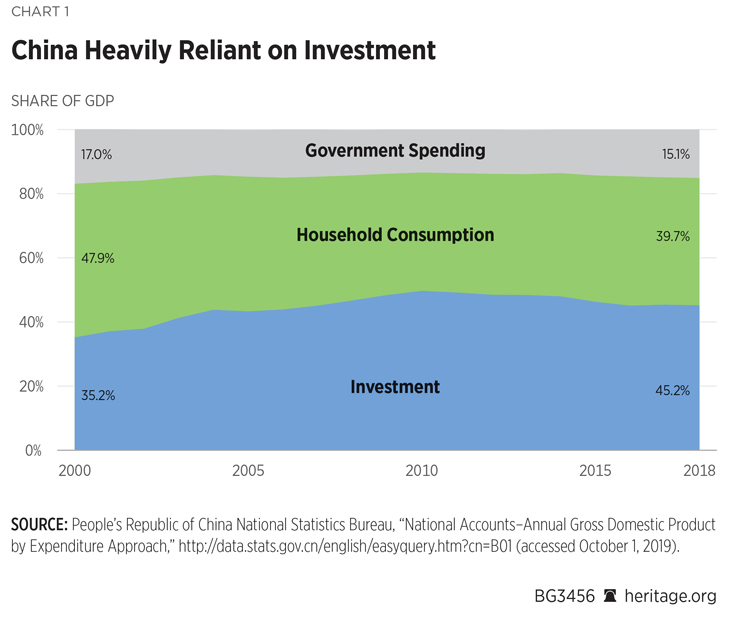
Like most developing nations, China is seeing a shift in production and employment from manufacturing to services industries. China’s service industry has continued to grow nonstop for the past two decades, offsetting the decreases in employment in agriculture and manufacturing. But within the next few decades, China will see more issues around employment as its population ages.
Right now, China has a population of 1.4 billion, but only 800 million (58 percent) are considered economically active. By 2050, China is expected to see its working-age population, including those not active in the economy, decrease by almost 200 million, to 839 million. This is partly the result of years of population control by China’s government.REF Meanwhile, its elderly population—those above age 65—is expected to nearly triple.REF
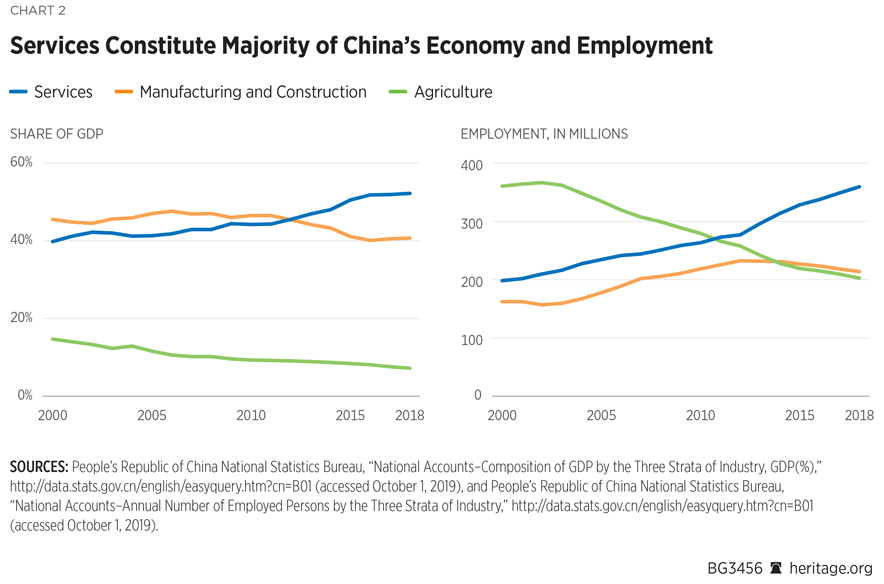
The fact that China has a population four times that of the U.S., within an area roughly the same size as the U.S., does not make producing accurate numbers any easier and only adds to the trouble of using official statistics as a reliable measure.
One way is to measure wealth, or the total assets, in China. China has a total wealth of roughly $54 trillion, 18 percent of total global wealth.REF This puts the median wealth per adult in China at $20,942, significantly higher than it used to be, but still far from other major economies. The U.S. has $106 trillion in wealth ($65,904 per adult). Japan has $25 trillion ($110,408 per adult).
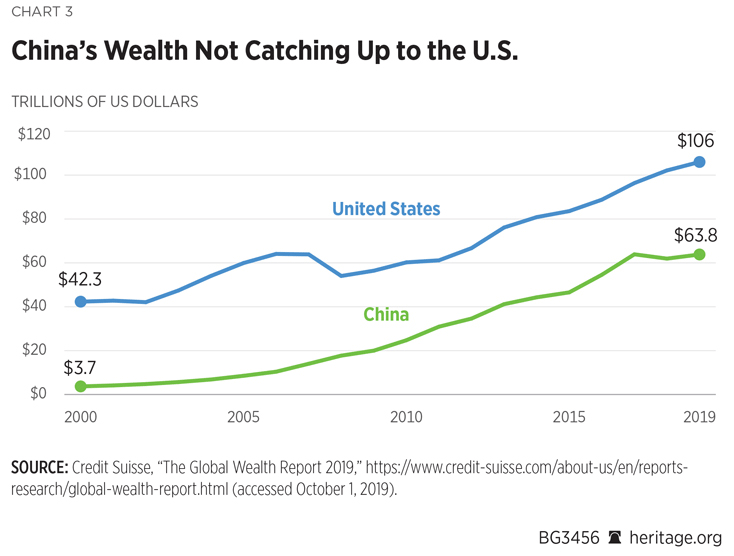
Household Income. Growth in household income, like wage growth, may also be a better measure of China’s economy than GDP. It is also a good leading indicator of consumption, which is the main driver of China’s economy these days. Higher consumption comes from three things: higher income, fewer savings, or higher debt. China happens to be experiencing all three.
Per person annual household income in China was RMB28,200 (about $4,267) in 2018. This is with an average growth of 9 percent a year for the past five years. However, there is a big difference in household income growth between rural and urban households. Between 2001 and 2009, urban households saw faster growth in their income than rural households, given the heavy investments in coastal and port cities. In 2018, urban household income was RMB39,300 (about $5,946). Rural household income was roughly one-third of that at RMB14,600 (about $2,209).
To put these numbers into context, it is important to know that 40 percent of China’s population, 564 million people, live in rural areas. Rural household income growth is slightly higher than urban household income growth now, but neither income is growing as fast as a decade ago.
China’s Savings. One often-noted statistic about China is that it has a particularly high savings rate. A high savings rate has allowed higher levels in investment inside and outside China. The household savings rate is roughly 23 percent of GDP. At 46 percent of GDP, China’s national savings rate is higher than that of most economies. But independent research suggests that the savings rate may be closer to 40 percent.REF Still, China’s national savings rate is higher than what Japan, South Korea, and Taiwan, experienced through their economic development. Despite being considered a developing country, China’s corporate saving rate is about the global average of 15 percent of GDP.
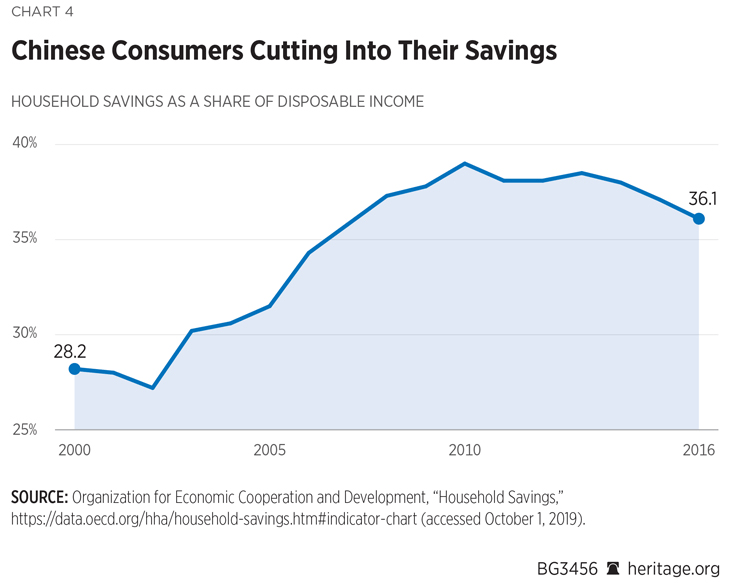
An International Monetary Fund (IMF) report suggests there are three reasons why China’s savings rate is so high.REF One reason is that the savings rate is another side effect of the Chinese government’s two-child (formerly one-child) policy—a national policy of population control that has been around since the late 1970s.REF With the limited number of children being born, parents spend less money on investing in their children, allowing more savings. According to IMF estimates, this can explain half of the rise in China’s household savings. The second and third reasons are market uncertainty, and increasing housing, medical, and education costs, which all require higher savings.
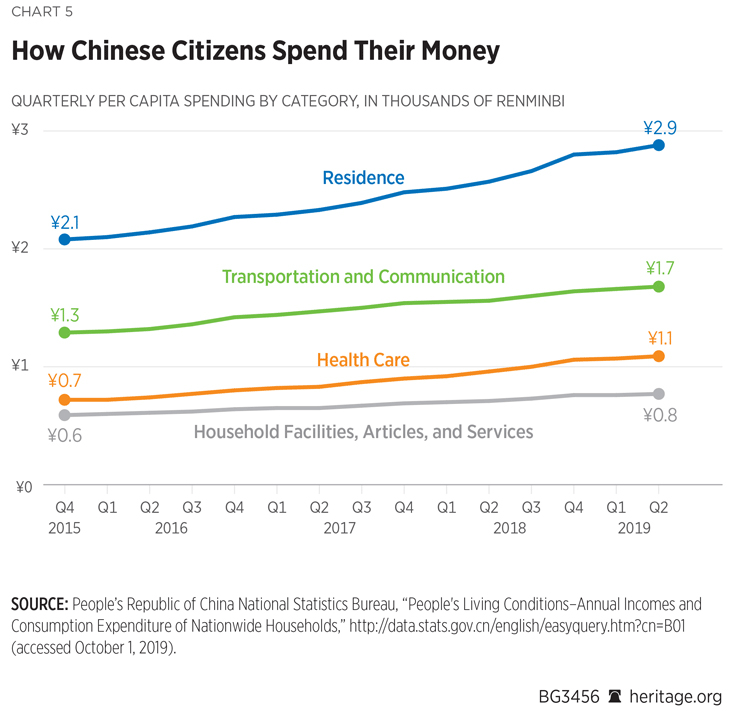
The Great Wall of Debt. In those cases when China’s rising demand for more goods and services is not being paid for with increasing income or savings, it means that more people are taking on debt. And more debt can put downward pressure on future consumption. Meaning, while China may be having a consumer boom right now, it may be short-lived.
At this point, the majority of China’s total debts have gone to corporations. The growth in China’s national debt coincides with a significant fiscal stimulus announced by China’s government in 2008.REF Since then, China’s government has been running an increasing fiscal deficit. According to the People’s Bank of China, China has almost RMB86 trillion (95 percent of GDP) in domestic securities outstanding including government debt and financial and corporate bonds.REF This could be troublesome for a country like China as it limits its options to respond to any future economic crisis.
In the face of China’s recent economic slowdown, China’s central bank has eased the amount banks are required to keep on hand in order to boost loans and economic activity.REF
China now has the debt level of a high-income economy. Over the past decade, total private and government debt in China has increased significantly from RMB62 trillion ($9.1 trillion) at the end of 2009REF to RMB228 trillion ($34 trillion), 254 percent of GDP at the end of 2018. Most other developing economies, such as Colombia and Thailand, only have total debt levels of somewhere between 100 percent and 150 percent of GDP.
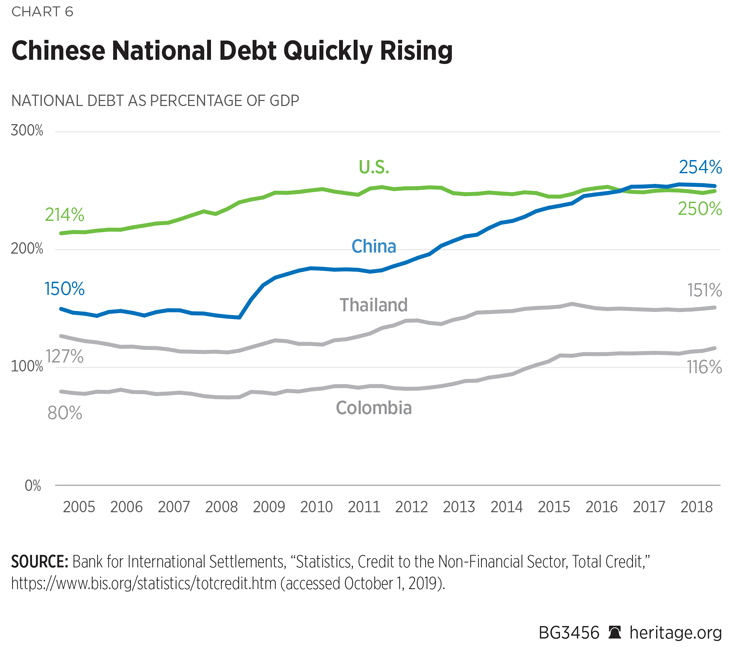
China’s Economy Is Still Growing, Just More Slowly
China’s economic growth hit a turning point after 2008. Whether it was an effect of the global financial crisis or China’s leaders’ near-abandonment of market reforms, it is clear from the data that China is no longer seeing the growth it experienced in the 1990s and 2000s.REF
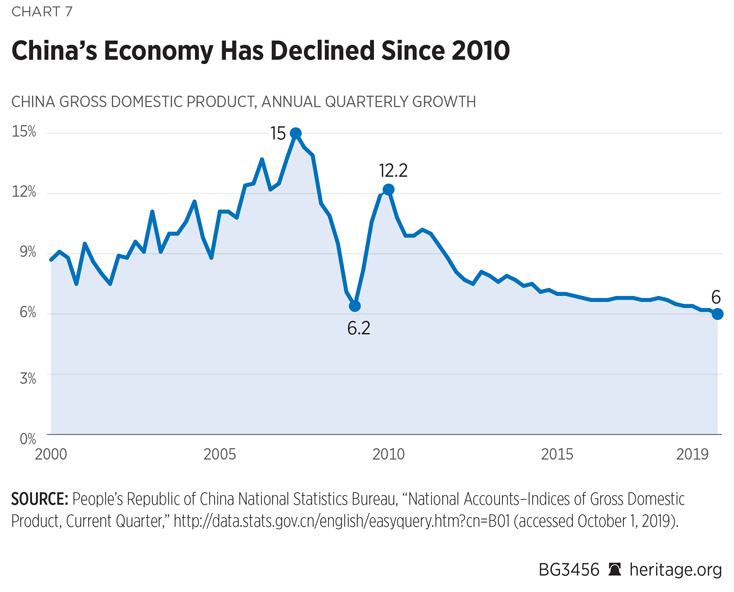
According to China’s National Statistics Bureau, quarterly GDP growth (at 2015 prices) averaged above 10 percent between 2000 and 2010. There were even years when China experienced annual GDP growth as high as 14 percent.REF However, after 2008, GDP growth has been steadily declining. In 2012, GDP growth dropped to below 8 percent. In 2015, it went below 7 percent. This year, China saw the lowest growth in GDP in almost 30 years with a quarterly GDP growth rate of 6.0 percent in its third quarter (the months of July, August, and September). The IMF predicts that China’s GDP growth will drop below 6 percent in 2022.REF Depending on the negative effects of China’s own increasing trade barriers for U.S. imports, as well as losses to its domestic farming industry, China may drop below 6 percent even sooner.
U.S. officials should not be overly reliant on GDP numbers. GDP is an accounting tool that more or less measures the flow of purchases in a year, and it is often mistakenly used as a measure of wealth. However, GDP can overstate a nation’s economic productivity when GDP measures consider government spending as a constant net positive. And, GDP can underreport productivity, given that statisticians count the import of goods and services against GDP growth, even though consumers clearly benefit from imports.
China’s GDP numbers are particularly unreliable, given that officials sometimes inflate statistics in order to meet growth targets.REF There can often be large differences between local and national economic statistics in China. Measuring the growth of China’s nominal GDP (GDP at current prices), China’s economy grew 9.7 percent between 2017 and 2018. There is no doubt that China’s GDP growth has been positive over the years with nominal growth averaging over 11 percent since 2009. But research suggests that Chinese officials have been overstating GDP numbers for the past decade.REF Specifically, China’s National Statistics Bureau has been overestimating national investment, thereby inflating GDP growth statistics. In fact, nominal GDP growth between 2010 and 2016 may be 1.8 percentage points lower than the official record. Investment and savings rates may be as much as 7 percentage points lower, and industrial growth is being overstated as well.REF
There were previous occasions in the provinces of Liaoning and Inner Mongolia where local officials changed their “official” statistics, some of which were originally faked. According to research, “local statistical bureaus are susceptible to pressure by local officials who may have an incentive to report inaccurate statistics.”REF Growth targets dictated by China’s leaders create incentives for abuse and ultimately harm China’s credibility.
Forever a Middle-Income Economy?
A middle-income economy is measured as having a national income between roughly $1,006 and $12,235 per person per year. The World Bank views China as an upper-middle-income economy (having an income per person of $9,470 per year).REF China’s slowing economy is at risk of getting stuck as a middle-income economy. The middle-income trap is when a developing economy, such as China, not only slows down in growth but has historically experienced enough growth that domestic wages have increased to a point of undermining its competitive advantage. Investors instead end up looking to other developing economies for lower wages and higher profit margins.
Wage growth in China has exceeded GDP growth for years. The benefit to wage growth, though, is higher consumption, and typically a higher standard of living. As seen in China, there has been a boom in consumerism, but increasing wages also put downward pressure on domestic business profits.
Increasing debts put pressure on businesses as well as consumers. Still, given how much certain countries, particularly those in Asia that heavily rely on trade with China, have benefited from China’s economic growth, slowdown and stagnation will not go unnoticed. Any significant slowing of China’s economy will have a drag effect on countries in Asia, especially those that are still developing.REF And, there are already concerns about the future growth of some developed economies, such as Japan, South Korea, and Taiwan.
Unfortunately, China is nowhere near the sustainable path that Japan or South Korea were on during their periods of economic development.REF Demographically, when it began its development path, China was already older than South Korea and will grey before reaching Japan’s development.
A Growing Culture of Consumption
An economy, such as China’s, that increasingly consumes more, can be taken as a positive sign of economic development. Last year, retail sales of consumer goods were over 38 trillion renminbi, an increase of 186 percent from just 10 years ago. China is developing a consumer culture that is particularly modern. Consumers in China can be seen as developing a pattern similar to a recent U.S. trend where television viewers “cut the cord” by moving away from traditional cable television to on-demand, Internet-based screening services. This implies that more Chinese consumers are spending their income on Internet-accessible and mobile-phone-platform services.
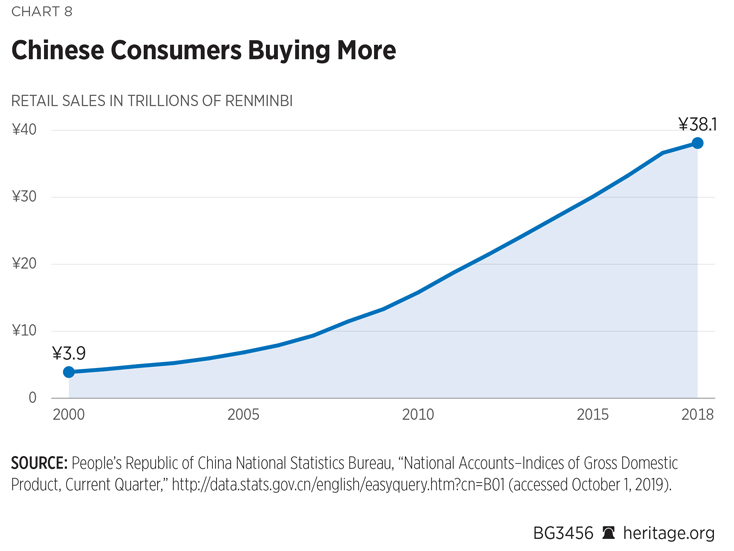
Today, there are more than 770 million Internet users in China, almost 98 percent of whom access the Internet through their mobile phones.REF China’s e-commerce trade volume was RMB31.63 trillion (about $4.8 trillion) in 2018,REF with Internet-dependent businesses, such as Alibaba, China’s version of Amazon, being able to make as much as $30 billion in sales in one day.REF
Greater Internet access has also allowed China to become the largest market in the world for financial technology (fintech). In major Chinese cities, it is hard to buy anything without having to pay with a cell phone app, through services like Alipay or WeChat Pay. While the U.S. is still a large market for fintech, credit volume through these types of services is seven times larger in China, with $241 billion in credit in 2016.REF
A more mobile, richer, and on-demand market has allowed China’s so-called sharing economy to flourish as well, despite the cybersecurity and political risks that come from increased online exposure. The sharing economy, which provides the ability to engage in person-to-person economic activity through the Internet, has grown from RMB1.9 trillion (roughly $302 billion) in 2015 to over RMB2.9 trillion (roughly $439 billion) in 2018.REF Around 760 million Chinese participate in China’s sharing economy by sharing cars, ordering food or medical care, or traveling, just to mention a few components. China’s sharing economy is expected to grow another 30 percent over the next three years, meaning there will be more demand for services.
Economic success can be measured by any number of indicators. Along with higher household income is the fact that there were more than 189 million private-passenger vehicles in China last year, double the number from just five years ago. But consumers can only buy so many cars. Lack of demand is one reason why the growth of car sales in China has been in decline for almost a year now.REF
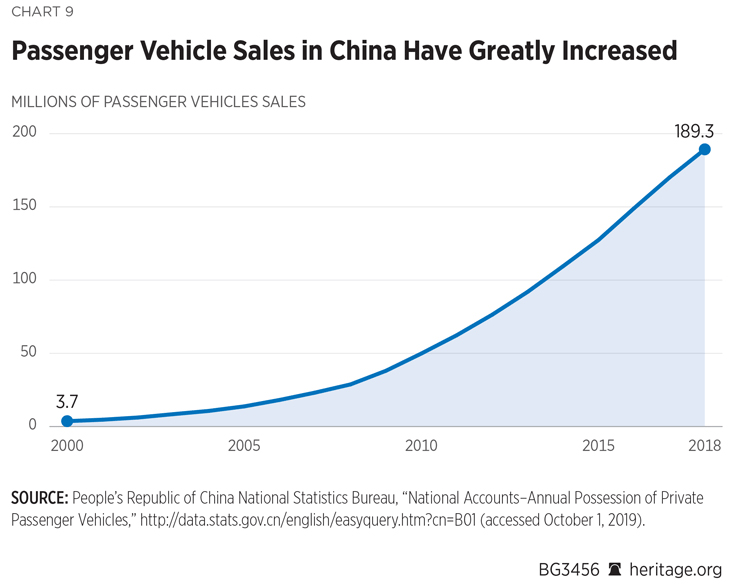
Perhaps, economic success is not measured by the number of goods someone can purchase, but by life experiences that cost money. A good measure for this could be the number of travelers in a year. Last year, almost 162 million Chinese traveled outside China.
However success is measured, the success of Chinese consumers is no threat to the U.S. In fact, economically, it can be a net benefit for the U.S. economy.
Deleveraging with No Teeth
With greater economic development, there have been more business start-ups in China. In 2017, China had more than 18 million corporate enterprises—of which at least 325,000 were state-owned or state-funded.REF
As of June 2019, China had more than 336,000 industrial enterprises, which have created roughly RMB6.6 trillion ($1 trillion) in annual profits. But there has been almost no growth in industrial enterprises’ profits for the past 5 years. For foreign investors, there is still profit potential in China despite the regulatory hurdles and political uncertainty. But the growth in profits and returns on investment in China are simply not what they used to be.
Lower profits can put pressure on accumulating debt. Loss-making businesses in the industrial sector lost more than RMB794 billion ($120 billion), the equivalent of 12 percent of total profits, in 2018, which helps to explain the large amounts of debt in China’s corporate sector.
Unprofitable businesses in China are not new. There were 69,000 loss-making SOEs with losses upwards of RMB1.4 trillion ($207 billion) in 2017.REF In 2005, there were just over 226,000 industrial enterprises. At that time, more than 57,000 (one in four) were loss-making with RMB192 billion ($23.4 billion) in annual losses.
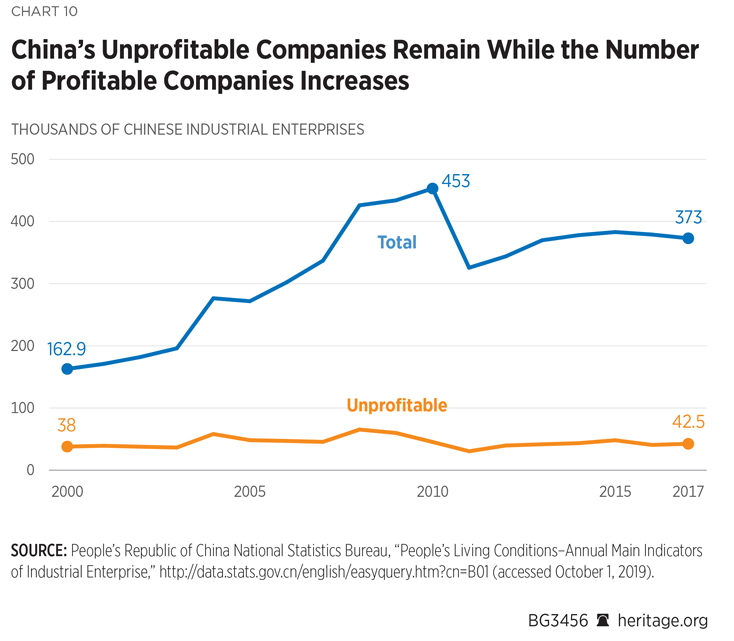
Chinese leaders have attempted to address concerns over growing debt and loss-making enterprises but have been hesitant to make any significant commitments. Given that China already has a questionable economic trajectory, it could be that leaders are fearful of sending China’s financial system over the tipping point. The last thing that Chinese leaders want is unemployed citizens protesting in the streets. That is why previous efforts to deleverage debts have been more conceptual than practical.
And, perhaps that is because China also has a problem with “zombie” corporations, or those enterprises that have consecutive years of losses. These corporations tend to have low performance, they overproduce, adding to overcapacity, and are often state-owned. Their existence is one reason why China continues to experience slower growth. There is little political appetite to actually allow these corporations to close.
Instead, zombie enterprises are kept around by a stream of easy bank loans and government subsidies, further adding to China’s debt problem. State support for SOEs, zombie or not, in the form of subsidies, low interest rates, and implicit political power in the market, is estimated at about 1.4 percent of GDP.REF
Without government support, SOEs could see almost a one-third less in returns, freeing up capital for more efficient allocation. Low-return SOEs tend to invest, and therefore waste, more than high-return SOEs. Their investments can be politically positive in local areas instead of economically justified.
Getting rid of these inefficient enterprises could add anywhere between 0.7 percentage points and 1.2 percentage points to national productivity.REF Previously, about 9,000 in local and central SOEs were identified as zombie enterprises. While some may close from financial pressure, those that are state-owned are 30 percent more likely to remain open because of political support.
One of the Chinese government’s most recent attempts to tackle its outstanding debt problem started in 2016. It began implementing an exchange of debt for equity for those companies with outstanding loans, but zombie enterprises were not allowed to participate. By 2019, RMB910 billion ($131.8 billion) was processed through this debt-for-equity program.REF However, this is only a fraction of the RMB143 trillion ($22 trillion) in nonfinancial corporate loans that still exist.
It would be better for China’s economy if the more unprofitable companies simply closed. More bankruptcies are required for that to happen, though. That is why the number of bankruptcies in a year can actually be a positive indicator, as it can be interpreted as the least-efficient businesses leaving the market. Between 2015 and 2018, the number of bankruptcies in China increased from 2,352 to just under 11,700.REF
Yet, just like subsidies to SOEs can be politically motivated, so can opposition to bankruptcies. According to Tianlei Huang from the Peterson Institute for International Economics, “local government intervention has contributed to blocking local state firm bankruptcies…. The insolvent state firms would rather live on the continued support of the government and creditors than liquidating assets to repay debt.”REF Meanwhile, the number of mergers and acquisitions, another sign of positive economic activity, has increased over the past three years as well, signaling that reform is not for naught.
Given that China’s economic development is often compared to Japan’s development, it is important to note that Japan had a large number of SOEs during the height of its economic development. Between 1971 and 1981, the annual Japanese government budget had increased from 20 percent to 34 percent of gross national product (GNP).REF By 1984, total government debt had reached 52 percent of GNP—higher than the U.S. or U.K. at that time. It was not easy, but eventually strong political power moved Japan to privatize many of its SOEs, especially those most unprofitable, allowing Japan to become as prosperous as it is today. There is no indication that China’s government has the political will to do away with its SOEs, even those that are unprofitable.
It’s Their Party, We’re Just Invited
For Chinese leaders, support for the Chinese Communist Party (CCP) is more important than the profitability of any SOEs. Chinese President Xi Jinping made this clear in his 2019 speech when he stressed the need to increase membership in the CCP, expand China’s socialist teachings, and ensure political security.REF These goals can be further disseminated to the way Chinese leaders think about China’s economy. For them, China’s economy should be stable, independent, and free from foreign control. The problem is that economic progress is naturally disruptive.
Reform of China toward a market economy, and therefore efficient economy, is necessary but politically difficult since it requires giving up power. The fact that China is led by a communist government will always conflict with efforts to free its economy from government intervention, despite Chinese leaders’ efforts over the past few decades to limit government interference in the economy.
There will always be this conflict between what the relatively few members of the CCP and the 1.4 billion people that make up the Chinese market want.
China’s national and local SOEs maintain upwards of RMB58.8 trillion ($8.9 trillion) in annual revenue.REF No matter how unprofitable some of them may be, that kind of money and power is hard to give up. So it is easier for Chinese leaders to limit SOEs’ competition than actually making SOEs more competitive. To do this, the Chinese government publishes lists that both encourage and restrict certain sectors from market access for both domestic and foreign investments. These sectors can be considered core to the CCP’s interests.REF
Of course, China’s economy is not communist by historical standards. Meaning that all levels of production today are not at the command of the government. There are more privately owned companies in China every day. But ultimately, businesses can only operate in China if the CCP allows it.
Limited Market Access. China’s government imposes a number of restrictions on foreign investment in China. These include prohibiting investment in certain industries and requiring foreign investors to enter into a joint venture. Often, the foreign investor is required to enter as a minority shareholder. China’s 2019 Foreign Investment Negative List restricts foreign investment in 13 sectors, with 40 specific industries that are restricted. Though this is less than the 48 industries that were restricted in China’s 2018 Negative List, or the 63 industries in the 2017 Negative List, it is still restrictive.REF
The 13 restricted sectors are: agriculture and fishing, mining, manufacturing, energy, tobacco production, transportation and postal services, telecommunications, finance and insurance, legal services, scientific research, education, health and social work, and media and entertainment.REF Access to these industries is further limited by China’s “Market Access Negative List.”REF
While China’s government recently passed a law that says foreign investment will be treated the same as Chinese investment, investment of any kind remains heavily regulated. The law does not go into effect until January 1, 2020.REF In the meantime, Chinese restrictions on fisheries, insurance, and shipping will remain higher than most economies measured by the Organization for Economic Co-operation and Development.REF
U.S.–China Investment. China is the second-most popular destination in the world for investment, only after the U.S., despite the country’s restrictions on investment. To date, countries have directly invested more than $1.8 trillion in China. While the majority of direct investment in China comes from Hong Kong, the U.S. is China’s second-largest foreign investor.REF
By 2018, the U.S. had invested more in China than in Mexico, with more than $116 billion—making China the 13th most popular destination for U.S. direct investment on a historical basis.REF This investment supports more than 2.1 million jobs in China, slightly more than the 1.7 million jobs in the U.K. or 1.6 million jobs in Mexico that U.S. investment supports.REF The majority of U.S. investment in China is in manufacturing, with $58.5 billion. The U.S. has invested in China manufacturing since the 1980s, long before China’s entry into the WTO. China is the fourth-largest destination for U.S. manufacturing investment, behind Canada ($110.1 billion), the U.K. ($96.9 billion), and the Netherlands ($77.0 billion).
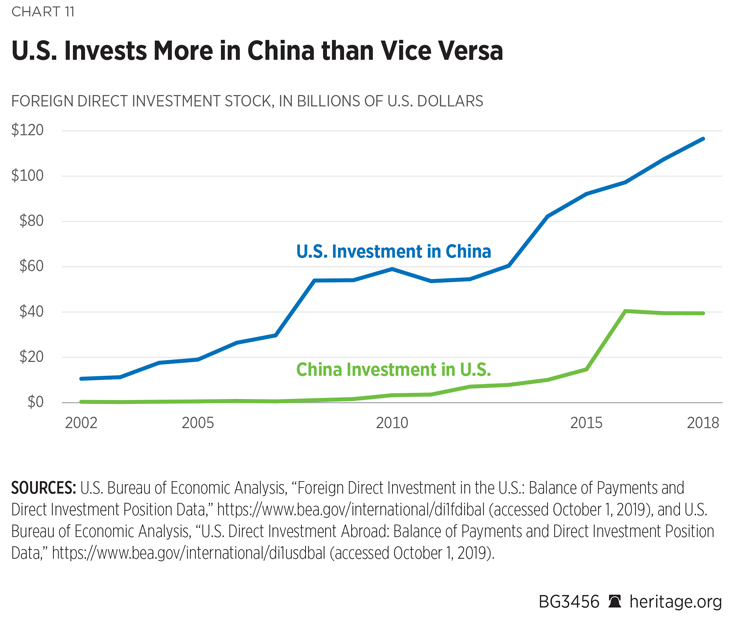
However, Chinese investors are not a major investor in the U.S. With only $39 billion in direct investment in 2018, investment from China is the 16th-largest source in the U.S. on a historical-cost basis.REF It is not a significant amount when considering that Chinese investment makes up less than 1 percent of total foreign direct investment in the U.S. It is a fraction of what other countries, such as the U.K. ($561 billion), Canada ($511 billion), and Japan ($484 billion), have invested. Direct investment from these three countries was a combined $1,557 billion in 2018. This is natural, of course, given the long economic relationship the U.S. has had with these countries.
The amount of Chinese investment coming into the U.S. is significant, however, when considering that Chinese investment has only been coming into the U.S. since 2002. The largest concentration of Chinese investment is in manufacturing at $13.6 billion. This makes China the 14th-largest investor in U.S. manufacturing. Chinese investment supports more than 85,000 U.S. jobs.REF
In addition to jobs supported by the import and export of goods and services, or cross-border investments, between the U.S. and China, China has quickly become the fourth-largest destination for IP revenue (including fees for licensing U.S. products) and for U.S. companies. After Ireland, Switzerland, and the U.K., in 2017, U.S. companies earned more than $8.7 billion in IP revenue from China.REF
China’s Underperformance: Economic Freedom
China’s economic freedom has grown over the past 25 years, but at a snail’s pace. According to The Heritage Foundation’s Index of Economic Freedom, with an overall economic freedom score of 58.4 out of 100 points, China’s economy ranks 100 out of 180 economies in the world.REF In 1995, China’s economic freedom had an overall score of 52 points. But its freedoms have not grown as quickly as those of other economies. China’s economy is considered “mostly unfree” and ranks only 20th out of 43 economies in Asia. By comparison, Taiwan ranks 10th in the world with a score of 77.3. Vietnam ranks 128th with a score of 55.3, followed by India with a score of 55.2.
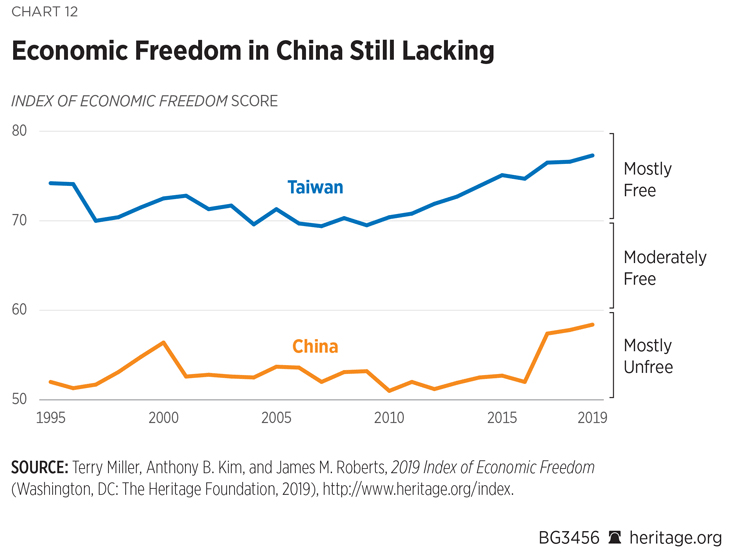
Economic freedom is based on several indicators that measure a country’s ability to administer the rule of law, whether its government is overbearing, and whether there is regulatory efficiency and an open-market system. China’s economic freedom score is hindered by low investment and few financial freedoms. It also has poor property rights and questionable government integrity. Business freedom in China is limited as well as the movement of labor. While these indicators have been improving slowly, international concerns over China’s government spending and fiscal health are growing.
Countries that have higher levels of economic freedom tend to be more prosperous. One might argue that China has been able to grow despite its limited freedoms. However, economic growth is not necessarily an indicator of economic freedom. And as it happens to be with China, the less free an economy, the more prone it is to experience inefficiency and corruption.
U.S.–China Trade
A year or two of increased tariffs on traded goods will not completely upend the past two decades of U.S.–China economic relations. China is the world’s largest exporter of goods and services. In 2018, it exported $2.7 trillion worth of goods and services globally.REF This was just slightly above the U.S., which had $2.5 trillion worth of exports. China’s exports represents roughly one-tenth of the world’s $25 trillion worth of exports. And 43 percent of China’s exports come from American and other foreign-invested enterprises.REF
It should come as little surprise that more of China’s exports go to the U.S. than to anywhere else. Americans purchased $559 billion worth of goods and services from companies in China in 2018—making China the largest source for U.S. imports that year. Imports from China have since decreased—by 12 percent so far in 2019—because of U.S. tariffs. But China will remain a top source for American imports. China is also one of the U.S.’s largest trading partners for goods. In 2018, the U.S. and China traded a total $660 billion worth of goods.REF The majority of products traded were industrial and consumer goods. Years of increased trade with China have been a gain of over $200 billion for U.S. consumers,REF and almost 1 million U.S. jobs are supported by exports to China.REF
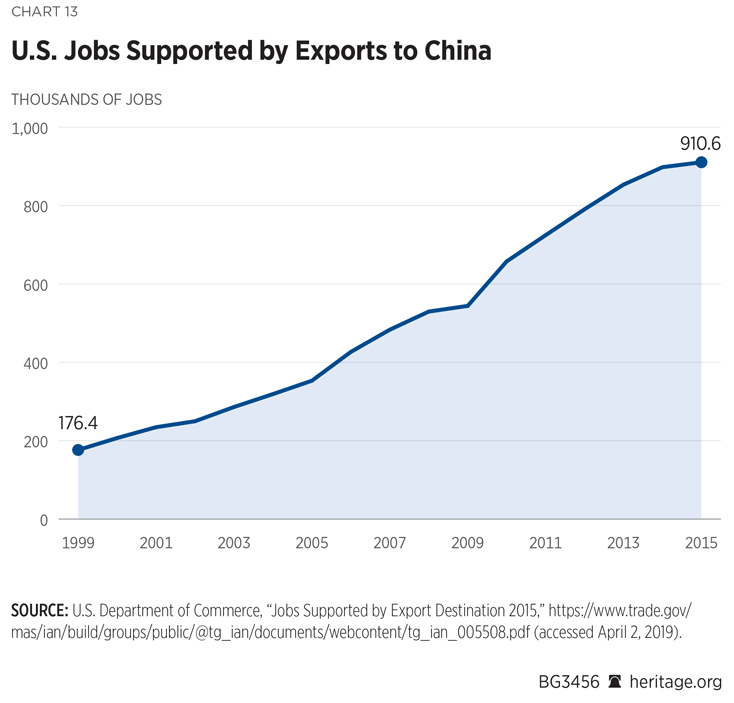
Like the U.S., though, China’s economy is not primarily supported by trade. Total trade (imports plus exports, including goods and services) with the world only makes up about 38 percent of China’s GDP—smaller than most developing countries. Vietnam’s total trade as a percentage of GDP is 188 percent. Total trade is 140 percent of Malaysia’s GDP. For the U.S., total trade makes up roughly 27 percent of GDP.
Total trade with China makes up only 3.6 percent of U.S. GDP. Total trade with the U.S. makes up 5.4 percent of China’s GDP.
China has an average applied tariff rate of 8.5 percent on imported goods, higher than the U.S. but not by much.REF In 2017, the U.S. had an applied tariff rate of 3.4 percent. China’s tariffs, however, are one of the things limiting its growth potential. The average applied tariff rate has stayed roughly the same for the past 10 years, despite efforts in 2018 to reduce tariffs on more than 1,500 consumer goods and auto imports.REF Historically, a reduction in China’s tariffs has increased domestic production and efficiency.REFBut China still has particularly high tariffs on the import of footwear (15.7 percent), vegetables (11.6 percent), clothing (10.3 percent), and consumer goods (11.4 percent).REF
However, just as the U.S. average tariff rate is rising due to the Trump Administration’s tariffs on the import of Chinese products like industrial, machine, and electronic goods, China’s applied tariff rate will increase along with the tariffs it has been placing on $110 billion worth of U.S. imports like agriculture and farm goods.
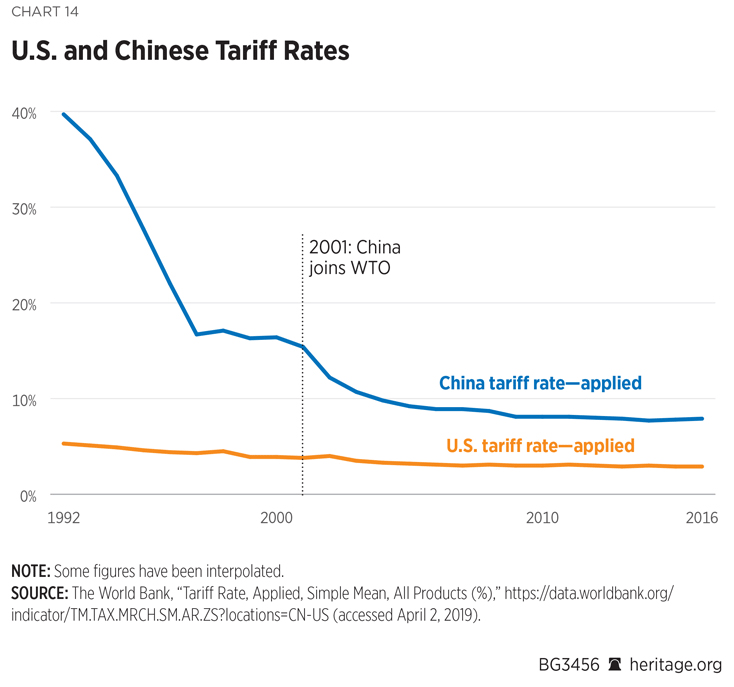
The U.S.–China Trade Dispute
The way that China’s leaders respond to China’s structural economic weaknesses, for the support they give to their SOEs, limitations they place on foreign investment, acquisition of IP through legal and illegal means, support for national champions, and other anti-market initiatives are why the Trump Administration began a multiyear trade dispute with China.
Specifically, on August 14, 2017, President Trump instructed the U.S. Trade Representative (USTR) Ambassador Robert Lighthizer to investigate China’s policies and practices related to technology transfer, IP, and innovation.
Ambassador Lighthizer concluded that China’s practices cost the U.S. economy at least $50 billion a year.REF These include:
- Joint venture requirements, foreign investment restrictions, and administrative review and licensing processes to force or pressure technology transfers from American companies;
- Discriminatory licensing processes to transfer technologies from U.S. companies to Chinese companies;
- Investments and acquisitions which generate large-scale technology transfer; and
- Cyber intrusions into U.S. computer networks to gain access to valuable business information.
In response to these practices, the Trump Administration announced a series of new tariffs between 15 percent and 30 percent on roughly $500 billion worth of imports from China. Essentially, imposing a $100 billion fine for a $50 billion crime. Beijing imposed its own tariffs on roughly $110 billion worth of exports from the U.S. in an effort to show its willingness to stand up to the Trump Administration.
While the Trump Administration’s trade dispute with China began with these four complaints, it has clearly expanded beyond that. It is not uncommon to hear officials in the Administration complain about Beijing’s ability to manipulate China’s currency, distribute state subsidies, and not buying enough American agricultural products or limiting the exports of opioid drugs to the U.S.—issues that are removed from the initial findings of the USTR.
Whether the U.S. and China eventually make a deal is more of a political question than any indication that tariffs have worked as a negotiating tool. Whether negotiations between the U.S. and China will be successful remains to be seen. Even then, meaningful reforms in China could take years to come to fruition. Beijing is in a catch-22. Any reforms that are announced as a part of a deal will only be in sectors where Chinese leadership feels that there is little risk to political interests. On the other hand, reform that does take risks—even if it suffices to placate Washington—will still not go far enough to propel the Chinese economy, because it they may be too little, too late.
Dealing with a Stagnating China
Looking at the China challenge from the perspective that China’s economy is neither collapsing nor on the verge of subsuming all in its path makes all the difference. It is better to see it as a very large, slowing economy with a myriad of weaknesses that revolve around the lack of economic freedom. China is not an economic powerhouse that must be confronted with an all-of-government approach that constrains private-sector activity through increased regulation, tariffs or taxes, and industrial policy.
China’s bad behaviors are sets of problems that need to be addressed through specific, targeted action. The American policy response to Chinese abuses should be to coax the Chinse toward free-market reforms and the rule of law, which would remove the need for China’s own self-harming economic and industrial policies. Washington should:
- Build America’s own economy by prioritizing economic freedom at home. Economic growth and prosperity is a function foremost of the domestic environment. Congress and the White House should further undo years of burdensome federal laws and regulations that have created significant costs for businesses and taxpayers, leading to billions in lost opportunities.REF Washington also needs to get its spending habits under control. An ever-increasing fiscal deficit calls into question the health of the U.S. government’s budget, impacts interest and currency rates, and creates uncertainties for future taxpayers.REF Trade should be made freer by removing tariff and non-tariff barriers (regulations) for imports.
- Build trusted trading partnerships. Membership in the WTO allows the U.S. to buy and sell products with the WTO’s 163 other members at much lower tariff rates than would otherwise apply. But tariff and non-tariff barriers should still be lowered. The U.S. only has free trade agreements with 20 countries. Even then, the U.S. has yet to build trade agreements with many countries in Asia most at risk from China’s economic slowdown. The U.S. should consider trade agreements with Taiwan, Japan, Vietnam, and other nations in the region.
- Re-establish a working dialogue with Chinese officials. The U.S. and China are important trading partners. It only makes sense for both sides to stay in continuing communication. With the exception of the ongoing Section 301 negotiations—about the four USTR complaints listed above—regular economic meetings with China have fallen by the wayside. The previous attempt at a U.S.–China Comprehensive Economic Dialogue lasted less than a year.REF It should be restarted. However, these meetings could limit negotiators’ ability to focus on China’s market liberalization if they are too broad. The phased approach that the Trump Administration has most recently taken in its trade talks with China offer a model for the future. Dialogues focusing on too many complaints at once are less effective. They are better taken in batches. Remaining issues in the current dispute, including subsidies and disciplines around SOEs, will be a good place to turn once phase one is complete. The parties could then resume regular meetings on market liberalization in specific sectors, such as financial services and e-commerce.
- Collect more information on China’s economy. Because official statistics can be unreliable, the U.S. should work to build its own measure of China’s economy. U.S. official statistics are compiled differently than China’s statistics, meaning that the comparisons are between apples and oranges. The Department of Commerce and the USTR should collect data on the amounts and types of subsidies and support that go to China’s SOEs. They should also rely on the growing number of third-party resources, intelligence sources, and other governments to provide a wide range of economic measurements. This information will form the foundation for any dispute the U.S. has with China’s government economic interventions, including at the WTO.
- Reform and support the World Trade Organization. China has a mixed-to-poor record living up to its WTO commitments.REF History shows, however, that when it has failed to comply and the U.S. has chosen to pursue dispute settlement at the WTO, the U.S. is very successful in winning cases.REF The U.S. uses the WTO dispute-settlement system more than any other member. And, China responds well to the disputes brought against it. The answer to China’s bad compliance record is not to go unilateral, but to double down on WTO solutions. The dispute system requires adjustments, and the Trump Administration should work with free-market allies to implement them. For instance, reducing the time it takes to adjudicate any dispute would significantly improve the WTO’s dispute-settlement system.REF There are also ambiguities that need to be clarified through a combination of bringing new cases against the ChineseREF and finding consensus among members to clarify commitments. Even in its current state, using the WTO would be more effective in building collective action against China’s practices that harm U.S. and foreign companies abroad than tariffs.
The U.S. should also:
- Apply sanctions to those who have violated U.S. IP rights through cyber means. Applying punitive tariffs on imports from China is a dispersed cost to American consumers that will not stop thieves from stealing U.S. IP. For those bad actors, Executive Order 13694 grants the Treasury Department authority to sanction foreign entities that have used cyber-enabled means to acquire U.S. IP.REF
- Pursue punitive action against foreign entities that have violated U.S. IP rights through non-cyber means.REF In cases were Chinese entities steal U.S. IP through non-cyber means, U.S. sanctions are successful in limiting the abilities of these foreign entities doing business abroad. The U.S. Department of the Treasury, along with information collected through the efforts of USTR and the Department of Commerce, should apply sanctions to those entities that have stolen, or knowingly use stolen, IP. Punishment can go as far as to include asset seizures.REF
- Fully fund and make use of the Committee on Foreign Investment in the U.S. (CFIUS). China’s government efforts to acquire U.S. technology include legal investments in the U.S. Most Chinese investment should be welcomed. But the U.S. can regulate foreign investment when it could pose a threat to U.S. national security. The CFIUS was recently updated to help deal with threats created by China’s foreign investment in the U.S.REFTwo important updates are (1) protecting Americans’ personally identifiable information, and (2) preventing the creation of new cybersecurity vulnerabilities. Recent reform also included an emphasis on making sure that emerging technologies that are critical to U.S. national security are not at risk of Chinese acquisition. Congress should make sure that the CFIUS is implemented in a way that is consistent with congressional intent and appropriately funded for managing its day-to-day operations.
- Support the Department of Justice’s and Department of Defense’s efforts to combat malicious Chinese activity. The Departments of Justice and Defense are actively working to deter and punish those bad actors that threaten the U.S. defense industrial base and commercial businesses.REFJustice efforts to indict bad actors are important for building legal cases and potentially applying sanctions against Chinese companies that have violated American IP rights. Not all criminal activity is at the direction of the Chinese government, either. Chinese government industrial policies aimed at acquiring critical technologies creates incentives for domestic bad actors to steal and illegally export U.S. IP.
- Encourage more Section 337 investigations. A significant measure of Chinese IP theft comes from the import of counterfeit goods. Section 337 of the Tariff Act of 1930 allows the U.S. International Trade Commission to respond quickly on behalf of U.S. victims. It is an effective tool for limiting the import of goods from China that violate U.S. IP rights to the U.S. market.REF Section 337 is another tool that the U.S. government, and industries, are not using enough.
Conclusion
The Chinese are guilty of much in their trading relationship with the United States, and President Trump is right to call them out. But there is a better way to do so than prosecuting a trade war. By recognizing the weaknesses in the Chinese economy for what they are, and isolating the specific issues at stake, the U.S. can design policy options that are practical and effective, and without imposing their costs on individual Americans.
Riley Walters is Policy Analyst for the Asian Economy and Technology in the Asian Studies Center, of the Kathryn and Shelby Cullom Davis Institute for National Security and Foreign Policy, at The Heritage Foundation.


